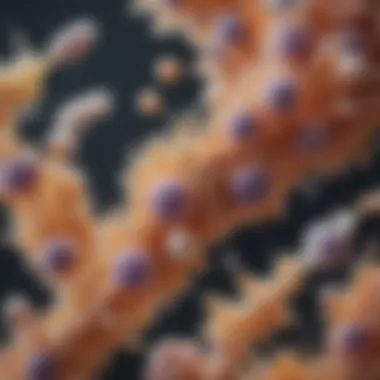Antibiotics and Candidiasis: A Complex Relationship


Intro
Candidiasis, an infection caused primarily by various species of Candida, poses significant health challenges. The relationship between antibiotics and candidiasis remains critical to understand, especially for healthcare providers and patients alike. With antibiotic use prevalent in modern medicine, the potential disruption of natural flora leading to fungal overgrowth is an area of increasing concern.
Those who utilize antibiotics often do so to treat bacterial infections without considering the resulting implications. Disruption of the body's microbiome can lead to conditions like candidiasis. This article focuses on the intricate dynamics between antibiotic use and the development of candidiasis, evaluating current research findings. Understanding this relationship can lead to better management of the infection and the development of strategies that minimize the risk of antibiotic resistance.
In the subsequent sections, we will cover recent advances in understanding how antibiotics influence candidiasis, treatment options available, and the crucial concept of antibiotic resistance. Insights from this discourse aim to enrich the knowledge of students, researchers, and healthcare professionals, highlighting the importance of informed antibiotic use.
Understanding Candidiasis
Understanding candidiasis is crucial for grasping the broader implications of antibiotics on human health. This fungal infection, primarily caused by Candida species, has become increasingly common. Antibiotics play a pivotal role in the development of candidiasis by altering the balance of microflora in the body.
Many healthcare professionals and patients may overlook the relationship between antibiotic usage and candidiasis development. However, the effects on normal flora can lead to significant health consequences, making it essential to comprehend this link. Additionally, recognizing the various types of candidiasis allows for better diagnosis and treatment strategies. This section will provide a detailed overview of candidiasis, establishing a foundation that informs the entire discussion of antibiotics' role in its management.
Definition and Overview
Candidiasis is an infection or disease caused by Candida, which is a type of yeast. It can occur in various parts of the body, most commonly in mucosal surfaces such as the mouth and vagina. The severity of candidiasis can range from mild to life-threatening, depending on the affected area and the individual's immune system health. The growing incidence of candidiasis highlights the need for awareness and understanding, especially in light of rising antibiotic prescriptions.
Types of Candidiasis
Candidiasis can manifest in several forms, each with distinct characteristics and implications for treatment.
Candidiasis of the Oral Mucosa
Candidiasis of the oral mucosa, often referred to as oral thrush, typically affects the mouth and throat. Its main characteristic is the presence of white patches on the tongue and inner cheeks. This type also offers an opportunity to assess the immune status of patients. Patients with weakened immune systems often experience oral thrush more frequently. Moreover, the treatment usually involves antifungal mouth rinses or systemic medications. Understanding oral candidiasis helps in recognizing potential signs of deeper health issues.
Vulvovaginal Candidiasis
Vulvovaginal candidiasis is a common issue for many women. This type of candidiasis manifests through symptoms such as itching, discharge, and discomfort. The primary characteristic is the localized inflammation in the vaginal area. It is crucial to address not only the symptoms but also the underlying causes, which can often be linked to antibiotic use. Treatment typically involves antifungal therapies, and an understanding of this condition can help in improving women's health outcomes.
Invasive Candidiasis
Invasive candidiasis is a more severe form, often occurring in individuals with compromised immune systems. This type is characterized by the fungus entering the bloodstream and can affect multiple organs. Its gravity makes it a significant concern in clinical settings. Invasive candidiasis requires prompt diagnosis and aggressive treatment, underscoring the necessity for medical professionals to understand its implications fully. Addressing this type underscores the inherent risks of antibiotic therapy and the need for careful monitoring.
Cutaneous Candidiasis
Cutaneous candidiasis presents itself as skin infections, typically in areas where skin folds are present, like armpits and groin. The major feature of this type is red, itchy, and inflamed skin. While it may often be overlooked, it holds importance in the discussion of antibiotic use since it can occur after prolonged antibiotic therapy. Treatment usually involves topical antifungal creams. Recognizing the signs of cutaneous candidiasis can lead to timely and effective management.
The Role of Antibiotics
Understanding the role of antibiotics is crucial when discussing candidiasis management. Antibiotics are primarily designed to combat bacterial infections. However, their impact on fungal infections, particularly those caused by Candida species, is nuanced.
The primary benefit of antibiotics is their ability to eradicate pathogenic bacteria. Nevertheless, this treatment can inadvertently disrupt the balance of normal flora – the diverse microorganisms that inhabit our bodies. This inclination toward antibiotics raises significant considerations for healthcare professionals. They must balance the necessity of antibiotic use against potential consequences, such as opportunistic infections like candidiasis.
Mechanism of Action of Antibiotics
Antibiotics function through several mechanisms. Some inhibit bacterial cell wall synthesis, while others interfere with protein synthesis or impair nucleic acid functions. These actions ultimately lead to the death or growth inhibition of bacteria. Some common classes of antibiotics include beta-lactams, tetracyclines, and macrolides.
However, antibiotics do not distinguish between beneficial and harmful bacteria. As a result, when antibiotics decimate bacterial populations, they can create an environmental void that allows Candida to proliferate unchecked. Understanding this process is essential for developing effective strategies to combat candidiasis.
Impact on Normal Flora
Normal flora serves as a barrier against infections, including those caused by fungi like Candida. When antibiotic treatment disrupts this flora, it can lead to dysbiosis – a microbial imbalance in the body. This imbalance increases the risk of fungal infections. For instance, after a course of broad-spectrum antibiotics, the likelihood of developing vulvovaginal candidiasis rises substantially.
Maintaining healthy normal flora should be a priority in antibiotic therapy. This can be encouraged through the use of probiotics, diet, and appropriate antibiotic selection. Recognizing the sensitivity of normal flora to antibiotic disruption is vital in reducing the incidence of secondary infections.
Antibiotic-Associated Candidiasis
Antibiotic-associated candidiasis refers to yeast infections that occur as a direct consequence of antibiotic use. This phenomenon is not rare. Studies indicate that up to 30% of patients receiving antibiotics might develop a subsequent yeast infection. The types of candidiasis often associated with antibiotic therapy include vulvovaginal candidiasis and oral thrush.


Factors such as the duration of antibiotic therapy, the particular class of antibiotic used, and individual patient characteristics can influence the risk of developing candidiasis. For healthcare providers, recognizing the signs of this association can aid in prompt diagnosis and treatment. Monitoring patients on antibiotics for symptoms of candidiasis can significantly improve outcomes and facilitate timely intervention.
"Antibiotic therapy, while beneficial for bacterial infections, can lead to unintended consequences that require proactive management strategies."
Candidiasis Pathogenesis
Understanding the pathogenesis of candidiasis is crucial in comprehending how Candida species can lead to infection. The process involves multiple factors, including the disruption of normal flora, the immune status of the host, and pre-existing health conditions. Each of these elements plays a significant role in how and why candidiasis occurs, particularly in those who may be at higher risk.
Factors Contributing to Candidiasis
Antibiotic use
Antibiotic use is a critical element that directly affects candidiasis development. It can disrupt normal flora in the human body, a process wherein antibiotics target not only harmful bacteria but also the beneficial microorganisms that help to keep Candida growth in check. This imbalance creates an opportunity for Candida species to proliferate. The key characteristic of antibiotic use here is its broad-spectrum effect, making it effective in treating infections but also a double-edged sword.
Consequently, the unique feature of antibiotic use lies in its ability to shift microbial populations. This leads to the overgrowth of fungi, like Candida. Its disadvantages include the increased likelihood of developing antibiotic-associated candidiasis, making it an important consideration for healthcare providers when prescribing antibiotics.
Immunocompromised states
The impact of immunocompromised states is significant in candidiasis pathogenesis. Conditions like HIV/AIDS, cancer treatments, or long-term use of immunosuppressive drugs reduce the body’s ability to fight infections. This vulnerability allows opportunities for Candida to thrive. The primary characteristic here is the weakened immune response, which is detrimental because it allows opportunistic pathogens to establish infections more readily.
In the context of this article, the benefit of discussing immunocompromised states lies in raising awareness about who might be at higher risk for candidiasis. The drawback is the need for heightened caution in these populations, as even minor infections can become serious.
Diabetes mellitus
Diabetes mellitus significantly contributes to candidiasis development due to its effects on the immune system and blood sugar levels. Elevated glucose in the bloodstream provides an ideal environment for Candida growth. The key aspect of diabetes is its chronic nature, which can impair bodily functions over time.
Addressing diabetes in this article is relevant as it highlights another risk factor, showcasing how unregulated blood sugar levels can led to increased candidiasis risk. Its unique feature is the interplay between blood glucose and immune response. Thus, diabetes can both predispose individuals to candidiasis and complicate treatment efforts through higher susceptibility to infections.
Hormonal changes
Hormonal changes, particularly in women, can also influence candidiasis susceptibility. Fluctuations in hormonal levels, especially during menstrual cycles, pregnancy, or hormonal therapy, can alter the vaginal environment and encourage Candida growth. The essential characteristic of hormonal changes is their periodicity, creating specific windows when individuals are more susceptible to infections.
Incorporating hormonal changes in this article emphasizes a significant risk factor often overlooked. It is important not only for women but for clinicians to recognize how these changes can influence treatment plans. The challenge here lies in managing candidiasis in patients whose hormonal fluctuations are expected, as it often requires a comprehensive treatment approach.
Candida Species and Their Virulence
Learning about various Candida species and their virulence factors is essential for understanding the mechanisms by which they can cause disease. Factors such as adherence, enzyme production, and biofilm formation play a role in the infectivity and treatment challenges associated with candidiasis.
Understanding the virulence of different Candida species aids in effective diagnosis and treatment strategies.
In summary, the understanding of candidiasis pathogenesis reveals the complexities behind its mechanism of infection. Factors such as antibiotic use, immunocompromised states, diabetes mellitus, and hormonal changes provide insights crucial for management and prevention of candidiasis. This understanding lays the foundation for better treatment strategies and highlights the importance of maintaining a healthy microbiome.
Diagnosis of Candidiasis
The diagnosis of candidiasis is crucial for effective management and treatment of this fungal infection. Early and accurate diagnosis can prevent complications associated with candidiasis. Healthcare providers rely on a combination of clinical presentation and laboratory diagnosis to confirm the presence of Candida species.
Understanding the Clinical Presentation
Clinical symptoms vary depending on the type of candidiasis. For instance, oral candidiasis may present as white patches on the mucosa, while vulvovaginal candidiasis often includes itching and abnormal discharge. Recognizing these symptoms ensures timely medical intervention. Hence, a solid clinical history is imperative.
Clinical Presentation
The typical indicators of candidiasis can sometimes overlap with other conditions, making clinical presentation critical for initial assessments. One key aspect is the characteristic appearance of lesions. In oral candidiasis, for example, lesions are often creamy white and can be scraped away to reveal erythematous mucosa beneath. In cases of vulvovaginal candidiasis, patients may experience intense itching and redness in the vaginal area, accompanied by a thick, curd-like discharge.
Understanding these signs is vital for distinguishing candidiasis from other infectious diseases. Without recognizing specific clinical signs, misdiagnosis can occur, delaying necessary treatment and potentially leading to the worsening of the condition.
Laboratory Diagnosis
Laboratory diagnosis is an integral part of confirming candidiasis. It provides objective data to complement clinical findings and helps to identify the specific Candida species involved. Various techniques are utilized for this purpose, each with unique strengths and weaknesses.
Culture methods
Culture methods involve growing Candida organisms from clinical samples. This allows for the identification of the species and testing for antifungal susceptibility. The key characteristic of culture methods is their reliability, making them a widely accepted standard in diagnostic microbiology. However, one disadvantage is that results can take several days, which might delay treatment initiation.


Additionally, some cultures may yield false negatives if specimens are not collected properly or if the Candida load is low.
Its importance in tracking antimicrobial resistance makes culture methods a valuable technique in candidiasis management.
Molecular diagnostics
Molecular diagnostics focus on detecting Candida DNA in clinical samples. This method is highly sensitive and allows for rapid detection of infections. A significant advantage of molecular methods is their ability to identify Candida species more accurately and quickly than traditional culture methods. However, these techniques require specialized equipment and trained personnel, making them less accessible in some clinical settings.
The specificity of molecular diagnostics provides valuable insights into the type of Candida involved in the infection. This aspect can significantly influence treatment decisions, especially in cases resistant to standard antifungal therapies.
Serological tests
Serological tests detect antibodies or antigens related to Candida infections in the patient's serum. This approach is particularly useful for invasive candidiasis, as it can reveal systemic infections. A key characteristic of serological tests is their ability to assess the immune response to the pathogen, providing indirect evidence of an ongoing infection.
While these tests can offer rapid results, they may not always be specific. Cross-reactivity with other fungi might lead to false positives. Thus, serological tests are often used in conjunction with other diagnostic methods for a comprehensive evaluation.
In summary, accurate and timely diagnosis of candidiasis is essential for effective treatment. Recognizing clinical presentations, alongside employing appropriate laboratory techniques, enables healthcare professionals to implement targeted and effective management strategies.
Treatment Strategies
The treatment strategies for candidiasis are essential in managing this fungal infection effectively. These strategies involve understanding the different therapeutic options available and deciding on the most appropriate course of action based on the specific type of candidiasis and the patient’s overall health. Proper management can not only alleviate symptoms but also prevent recurrence. This is critical in light of increasing reports of antibiotic resistance, which further complicates treatment protocols.
Antifungal Medications
Antifungal medications are the first line of treatment for candidiasis. There are several classes of antifungal agents, each with its own mechanisms of action and applications. The three primary types discussed here are Azoles, Echinocandins, and Polyene antibiotics.
Azoles
Azoles are a class of antifungal medications that inhibit the synthesis of ergosterol, a key component of fungal cell membranes. This disruption leads to cell death and is central to their efficacy. A primary benefit of Azoles is their oral bioavailability, which makes them a convenient option for outpatient therapy.
A key characteristic of Azoles is their broad spectrum of activity against various Candida species, which is advantageous in treating candidiasis. Among the most commonly prescribed Azoles are fluconazole and itraconazole. However, Azoles also have disadvantages; they can interact with various medications and may lead to resistance if used improperly.
Echinocandins
Echinocandins represent a newer group of antifungal agents that function by inhibiting the synthesis of glucan in the fungal cell wall. This unique mechanism makes them effective against resistant Candida strains, addressing a significant need in treating invasive candidiasis.
The key characteristic of Echinocandins like caspofungin and micafungin is their ability to work well in hospitalized patients, particularly those who are immunocompromised. These agents are usually administered intravenously, which can be a limitation for outpatient settings. Still, their potent antifungal activity makes them a favored choice when other treatment options fail.
Polyene antibiotics
Polyene antibiotics, primarily amphotericin B, bind to ergosterol in the fungal cell membrane, creating pores that lead to cell leakage and death. This method of action makes them effective against a wide variety of fungi, including resistant strains.
Their key characteristic lies in their powerful antifungal activity, which is why they are often reserved for severe cases of candidiasis. Polyene antibiotics, however, are associated with numerous side effects, including nephrotoxicity, which makes careful monitoring necessary during treatment.
When to Use Antibiotics
Deciding when to use antibiotics in candidiasis management involves weighing several factors. While antibiotics can be helpful in preventing secondary infections, their overuse may disrupt normal flora, potentially leading to candidiasis. It is important for healthcare providers to consider the patient’s overall health status and the specific fungal strain before initiating treatment. If a patient presents with a high risk of infection or shows signs of secondary bacterial infection alongside candidiasis, the use of antibiotics becomes justified. Therefore, a thoughtful approach is necessary to avoid any unnecessary complications or development of resistance.
Combining Treatments
In some cases, combining treatments can be beneficial for more effective management of candidiasis. Moreover, when antifungal agents are used alongside antibiotics in a controlled manner, this can help address both the fungal and bacterial components of infections.
Combination therapy may enhance treatment efficacy, especially in critically ill patients with multiple infections. However, this approach requires careful consideration of drug interactions and potential side effects. A comprehensive understanding of the pharmacodynamics of each agent is critical to ensure a balanced and effective therapeutic plan.
Effective management of candidiasis requires not only antifungal treatments but also a comprehensive understanding of how proteins and organisms interact to promote health.
Implications of Antibiotic Resistance
The implications of antibiotic resistance are paramount in understanding how it affects the management of candidiasis. As Candida species develop resistance to treatment, the effectiveness of standard antifungal medications may diminish, leading to increased health complications. The resistance can result from various factors, including over-prescription of antibiotics, inadequate dosage, or incomplete courses of treatment. These patterns enhance the survival of resistant strains, making candidiasis harder to treat.
Current Trends in Resistance


Currently, many Candida species have shown increasing resistance to commonly used antifungal agents. For instance, Candida albicans, the most prevalent species in human infections, has been observed to develop resistance to azoles through mutations in its enzyme pathways. Other species, such as Candida auris, present a significant challenge due to their multidrug-resistant profiles.
"The rise of azole-resistant Candida strains highlights a growing concern in antifungal therapy."
Monitoring resistance trends is crucial. Clinical laboratories and healthcare providers must communicate effectively about the resistance patterns noted in their patient populations. Limited treatment options can increase the length of hospital stays, healthcare costs, and patient morbidity. Thus, understanding these trends can inform more judicious use of antifungal medications and the development of alternative therapies.
Impact on Candidiasis Treatment
The impact of antibiotic resistance on candidiasis treatment is significant. With the rise of resistant strains, standard treatments may require adjustment, and clinicians must consider combination therapies. The absence of effective first-line treatments forces healthcare providers to use stronger, often more toxic medications, which can lead to adverse effects. This necessitates a more cautious approach when treating candidiasis, particularly in immunocompromised patients.
Furthermore, healthcare professionals need to be aware of emerging therapies. The development of newer antifungal agents that can circumvent resistance mechanisms is vital. Future research should focus on identifying mechanisms of resistance and developing treatment strategies that are adaptive and responsive. The outcomes depend not only on the innovation of new drugs but also on implementing better infection control practices in clinical settings.
Through an understanding of antibiotic resistance, stakeholders can create comprehensive public health strategies to mitigate the spread of resistant Candida species. It is essential to alter prescribing practices and foster better awareness of the implications of antibiotics on candidiasis. By embracing these changes, improved outcomes in candidiasis management can be achieved.
Preventative Measures
The significance of preventative measures in candidiasis management cannot be overstated. By implementing strategies that address potential risk factors, individuals can play a proactive role in reducing their susceptibility to this fungal infection. Various preventative measures not only help maintain the balance of healthy flora but also limit the overgrowth of Candida species, which is often precipitated by antibiotic use.
Reducing Antibiotic Use
Antibiotic use is one of the most critical factors contributing to candidiasis. Extensive use can disrupt the normal microbiota in the body, creating an environment conducive to fungal overgrowth. Thus, minimizing antibiotic prescriptions, particularly for non-bacterial infections, is essential. Physicians should adhere to guidelines that promote appropriate antibiotic use. When antibiotics are necessary, it is vital to choose narrow-spectrum agents that target specific bacteria rather than broad-spectrum antibiotics whenever possible. Additionally, patients should be educated about the consequences of self-medicating and the importance of adhering to medical advice regarding antibiotics.
"Overuse of antibiotics can lead to an imbalance in the microbiota, increasing the risk of infections like candidiasis."
Maintaining Healthy Flora
Maintaining a balanced microbial ecosystem is crucial for preventing candidiasis. This balance can be supported through diet and lifestyle choices. Probiotics are particularly beneficial as they contain live microorganisms that promote healthy flora in the gut. Incorporating foods rich in probiotics, such as yogurt, kefir, and fermented vegetables, can enhance the body's defenses against Candida.
Furthermore, minimizing sugar and refined carbohydrate intake is necessary because these substances can fuel Candida growth. A diet that focuses on whole foods, including vegetables, nuts, and lean proteins, helps sustain a healthy microbiome. Hydration also plays a role in flushing out toxins and maintaining overall health, so individuals should ensure they drink plenty of water.
Lifestyle Modifications
Adopting specific lifestyle modifications can further reduce the risk of candidiasis. Regular exercise contributes to a healthy immune system, which is key in fighting infections. A consistent sleep schedule also supports immunity, as inadequate sleep can compromise the body’s defense mechanisms.
Stress management is equally important, as chronic stress can negatively affect immune function. Engaging in mindfulness practices like yoga or meditation can help manage stress levels effectively.
Finally, individuals should be mindful of their personal hygiene, particularly in moist areas of the body where Candida can thrive. Wearing breathable clothing and avoiding prolonged moisture exposure can aid in preventing fungal infections.
Through these combined measures, individuals can effectively mitigate their risk of candidiasis, ensuring a healthier overall state.
Summary and Future Directions
The exploration of antibiotics and their role in the management of candidiasis proves to be essential for both healthcare providers and patients. Understanding the relationship between antibiotic use and fungal infections broadens our view of treatment strategies and preventive measures. It also highlights the risks associated with antibiotic misuse and overuse, which can lead to an imbalance in normal flora and potential candidiasis outbreaks.
In summary, an integrated approach is necessary. Healthcare professionals should carefully assess when antibiotics are prescribed, ensuring they are used judiciously. This not only combats bacterial infections but also helps maintain the natural balance of flora in the body, thereby reducing the risk of candidiasis.
Key points include:
- The necessity of antibiotics in bacterial infections.
- The role of antibiotics in disrupting normal flora, allowing Candida species to proliferate.
- Various types of candidiasis and their clinical implications.
- Treatment options that focus on both antifungal medications and lifestyle factors.
The future directions in this area involve continued research into the mechanisms by which antibiotics affect candidiasis. For example, exploring how specific antibiotic classes influence different Candida species could provide insights into tailored treatment plans. More comprehensive studies on preventative strategies and alternative therapies might also emerge as critical aspects of future research.
Review of Key Points
The discussion on antibiotics and candidiasis management centers on several key elements:
- Antibiotic Impact on Normal Flora: Antibiotics can significantly alter the microbial composition of the body. This is particularly relevant in patients undergoing long-term antibiotic therapy, where Candida may thrive due to disrupted equilibrium.
- Antimicrobial Resistance: Increasing resistance in both bacteria and fungi can complicate treatment. Understanding how resistance develops and spreads is crucial for effective management strategies.
- Types of Candidiasis: Knowledge of the various forms, such as oral, vulvovaginal, invasive, and cutaneous candidiasis, allows for more accurate diagnoses and tailored treatment options.
- Preventative Measures: Strategies to reduce antibiotic use and promote health can serve as critical safeguards against candidiasis.
"Antibiotics are indispensable in the fight against bacterial infections but caution should be exercised to avoid unintended consequences like candidiasis."
Potential Areas for Research
Research in candidiasis management is evolving, with potential areas for focus including:
- Impact of Specific Antibiotics: Investigating different antibiotics, such as penicillins versus tetracyclines, and their specific effects on Candida overgrowth.
- Role of Probiotics: Studying how probiotic supplementation during or after antibiotic treatment could help maintain healthy flora and prevent candidiasis.
- Antifungal Resistance Mechanisms: Understanding how Candida develops resistance to antifungals informs the development of new treatment strategies.
- Patient Education: Researching effective ways to educate patients on the prudent use of antibiotics and the implications for fungal infections can empower better health decisions.
- Longitudinal Studies: Conducting long-term studies to monitor the developing patterns of candidiasis among populations prescribed antibiotics regularly can yield valuable insights.
Such focused inquiry may enhance the effectiveness of current treatments and yield innovative approaches to managing candidiasis in our evolving healthcare landscape.















